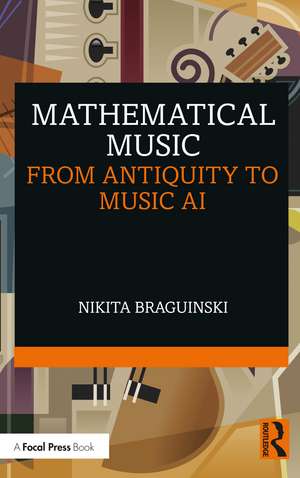Mathematical Music: From Antiquity to Music AI
Autor Nikita Braguinskien Limba Engleză Paperback – 14 mar 2022
This book provides a fascinating panorama of the gradual mechanization of thought processes involved in the creation of music. How did Baroque authors envision a composition system based on combinatorics? What was it like to create musical algorithms at the beginning of the 20th century, before the computer became a reality? And how does this all explain today’s use of artificial intelligence and machine learning in music? In addition to discussing the history and the present state of mathematical music, Braguinski also takes a look at what possibilities the near future of music AI might hold for listeners, musicians, and the society.
Grounded in research findings from musicology and the history of technology, and written for the non-specialist general audience, this book helps both student and professional readers to make sense of today’s music AI by situating it in a continuous historical context.
| Toate formatele și edițiile | Preț | Express |
|---|---|---|
| Paperback (1) | 256.00 lei 3-5 săpt. | +12.92 lei 4-10 zile |
| Taylor & Francis – 14 mar 2022 | 256.00 lei 3-5 săpt. | +12.92 lei 4-10 zile |
| Hardback (1) | 933.25 lei 3-5 săpt. | +14.43 lei 4-10 zile |
| Taylor & Francis – 14 mar 2022 | 933.25 lei 3-5 săpt. | +14.43 lei 4-10 zile |
Preț: 256.00 lei
Nou
Puncte Express: 384
Preț estimativ în valută:
49.01€ • 50.40$ • 40.66£
49.01€ • 50.40$ • 40.66£
Carte disponibilă
Livrare economică 27 ianuarie-10 februarie
Livrare express 10-16 ianuarie pentru 22.91 lei
Preluare comenzi: 021 569.72.76
Specificații
ISBN-13: 9781032062198
ISBN-10: 1032062193
Pagini: 146
Ilustrații: 4 Line drawings, black and white; 6 Halftones, black and white; 10 Illustrations, black and white
Dimensiuni: 138 x 216 x 11 mm
Greutate: 0.2 kg
Ediția:1
Editura: Taylor & Francis
Colecția Focal Press
Locul publicării:Oxford, United Kingdom
ISBN-10: 1032062193
Pagini: 146
Ilustrații: 4 Line drawings, black and white; 6 Halftones, black and white; 10 Illustrations, black and white
Dimensiuni: 138 x 216 x 11 mm
Greutate: 0.2 kg
Ediția:1
Editura: Taylor & Francis
Colecția Focal Press
Locul publicării:Oxford, United Kingdom
Notă biografică
Nikita Braguinski is a musicologist and historian of technology. He studied musicology at the University of Cologne and wrote his PhD in media theory at the Humboldt University of Berlin. He was a visiting postdoctoral fellow at the Max Planck Institute for the History of Science, a postdoctoral fellow of the Music Department at Harvard University, and most recently a postdoctoral researcher at Humboldt University where he wrote this book. He plays flute, piano, and guitar (but only when nobody is listening). His past musical experience ranges from playing in a rock band to jazz compositions, symphonic music, and electronic dance music.
Cuprins
List of figures
Acknowledgments
Composing with numbers (overview of this book)
From continuities...
1 Not a revolution (introduction)
2 Since antiquity
3 Since the Middle Ages
4 Since the early modern period
5 Since the 19th century
6 Since 1900
7 Since 1950
... to possibilities
8 Powerful and limited (introduction)
9 How does deep learning work?
10 Putting music AI in perspective
11 Real-world music AI
12 Mass-produced and still individual
13 Avant-garde becomes pop’s aide
Conclusion
Glossary
Bibliography
Index
Acknowledgments
Composing with numbers (overview of this book)
From continuities...
1 Not a revolution (introduction)
2 Since antiquity
3 Since the Middle Ages
4 Since the early modern period
5 Since the 19th century
6 Since 1900
7 Since 1950
... to possibilities
8 Powerful and limited (introduction)
9 How does deep learning work?
10 Putting music AI in perspective
11 Real-world music AI
12 Mass-produced and still individual
13 Avant-garde becomes pop’s aide
Conclusion
Glossary
Bibliography
Index
Recenzii
This wide-ranging book, accessible to those without extensive background in either music or mathematics, provides a fascinating history of the interrelationship between these two. Braguinski explains, with concrete examples, how recent musical AI is innovative in many ways, but how it also rests on deep foundations built in centuries past.
Nick Montfort, Professor of Digital Media, MIT, and Director of The Trope Tank
Nick Montfort, Professor of Digital Media, MIT, and Director of The Trope Tank
Descriere
Mathematical Music offers a concise and easily accessible history of how mathematics was in fact used broadly to create music.
